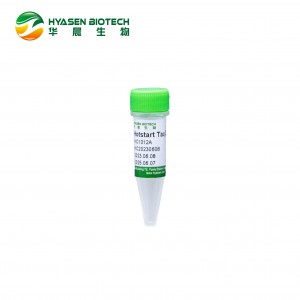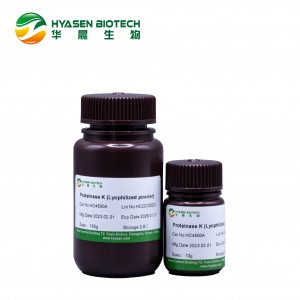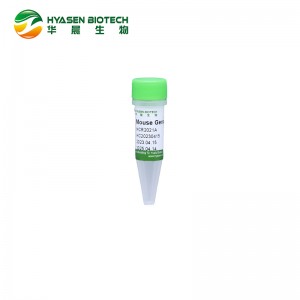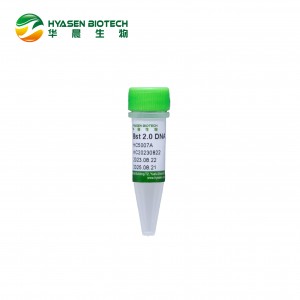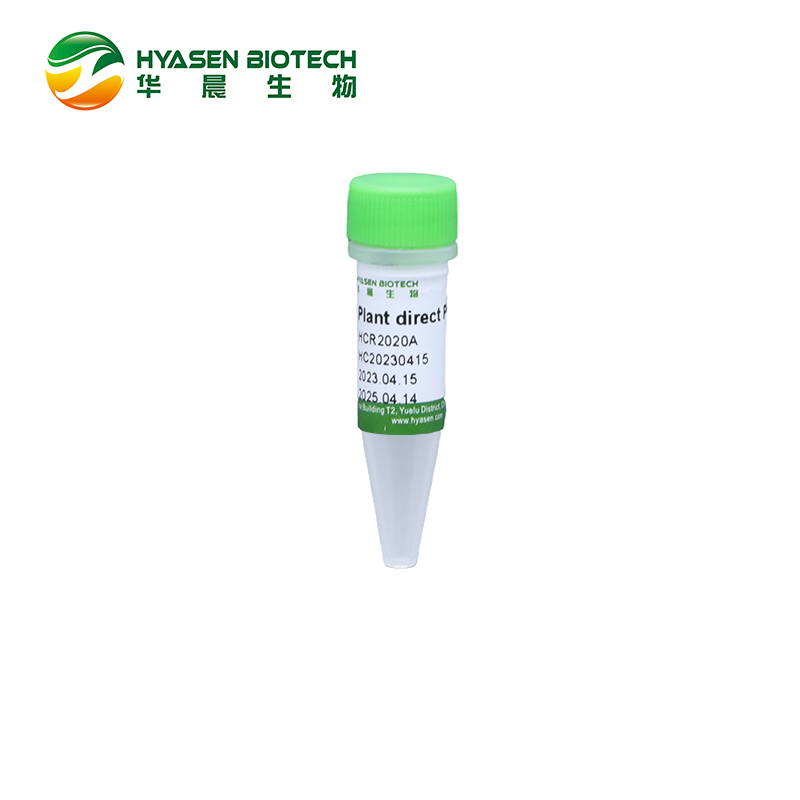
Plant direct PCR Kit
Cat No: HCR2020A
Plant Direct PCR Kit is suitable for direct amplification of plant leaves, seeds, etc., and can be used for high-throughput screening of plant samples that do not contain polysaccharides and polyphenols. The direct amplification DNA polymerase based on the directed evolution has superior tolerance to PCR inhibitors in plants. Meanwhile, it maintains the high amplification performance, which is suitable for the amplification of DNA fragments within 5 kb. The unique Lysis buffer A in the kit can be used to lyse fresh or frozen plant tissues. It is easy to operate and the lysate can be used as a template for amplification without purification. The system contains protective agents that enable crude samples to be effectively amplified after repeated freezing and thawing. 2 × Plant Direct Master Mix only needs to add primers and templates to perform amplification reaction, thereby reducing pipetting operations and improving detection throughput and reproducibility of results.
Components
|
Components |
50 RXNS |
200 RXNS |
|
2 × Plant Direct Master Mix |
1.25 ml |
4×1.25 ml |
|
Plant Direct Lysis Buffer A |
5 ml |
20 ml |
|
Plant Direct Lysis Buffer B* |
5 ml |
20 ml |
*Plant Direct Lysis Buffer B is an optional reagent, which is used to neutralize Plant Direct Lysis Buffer A for prolonging the storage time of samples. It can be used according to the actual situation.
Storage Conditions
2 × Plant Direct Master Mix, store at -30 ~ -15℃ and avoid repeated freezing and thawing; Plant Direct Lysis Buffer, store at -30 ~ -15℃ or 2 ~ 8℃.
Experiment Process
Sample Processing–Plant Leaf
Direct method: It is recommended to use young leaves. Use a hole punch with a fixed diameter of 0.5 – 3 mm to obtain a small and uniform samplea, and then directly add the sample to the PCR system (50 μl system is recommended). Note, make sure the sample is in the PCR solution and not against the tube wall. If direct PCR is used to amplify long fragments and complex samples, using a sample with a smaller diameter (0.5 – 1 mm) as a template can help to obtain better results.
Grinding lysis method: It is recommended to use young leaves. Take a small piece of leaf (about 1 – 3 mm in diameter), place it in 20 μl Plant Direct Lysis Buffer Ab, and grind it as much as possible (this step can be done by squeezing the leaf with a 100 μl pipette tip to mash the sample) . If larger volumes of leaf tissue are used (do not exceed 7 mm), increase the volume of dilution buffer to 50 μl. After the leaves are ground, the solution should appear green. After a brief centrifugation, add 1 μl of the supernatant to the PCR system as a reaction templatec .
Thermal lysis method: It is recommended to use young leaves. Take a small piece of leaf (about 1 – 3 mm in diameter), place it in 20 μl Plant Direct Lysis Buffer A, and heat it at 95°C for 5 – 10 min. The lysis time can be appropriately extended for leaves that are difficult to lyse (no more than 20 min). If larger volumes of leaf tissue are used (do not exceed 7 mm), increase the volume of dilution buffer to 50 μl. After heating, centrifuge briefly, and add 1 μl of supernatant to the PCR system as a reaction templateb.
Sample Processing–Plant Seed
Grinding lysis method: Use a scalpel to cut seeds with a diameter of 5 mm, add them to 100 μl of Plant Direct Lysis Buffer A, and grind the sample with a pipette tip or other tools. Vortex briefly and let stand at room temperature for 3 – 5 min. Make sure the seed sample is submerged in the dilution buffer. After a brief centrifugation, add 1 μl of the supernatant to the PCR system as a reaction template.
Thermal lysis method: Use a scalpel to cut seeds with a diameter of 5 mm, add them to 100 μl of Plant Direct Lysis Buffer A, and heat at 95°C for 5 – 10 min. The lysis time can be appropriately extended for leaves that are difficult to lyse (no more than 30 min). After heating, centrifuge briefly, and add 1 μl supernatant to the PCR system as a reaction templateb.
a. Scissors or other tools can also be used to cut samples of suitable size; if the punch or scissors are reused, they should be cleaned with 2% sodium hypochlorite solution before each use to prevent cross-contamination between samples.
b. Make sure that the Plant Direct Lysis Buffer is fully melted before use. If the buffer is viscous or has precipitates, it can be heated at 37℃ to melt it completely before use.
c. The volume of template in the reaction system can be adjusted appropriately according to the difference in the volume of plant material and diluent added.
Plant Direct Lysis Buffer
The Plant Direct Lysis Buffer A contained in this product has been strictly optimized to release the genome of most plant tissues and is suitable for short-term storage of crude plants at 4℃. If the sample needs to be stored for a longer period of time (e.g., 1 – 2 months), it is recommended to transfer the supernatant to a new EP tube and store it at -20℃. To store the samples more stably, add an equal volume of Plant Direct Lysis Buffer B to the transferred supernatant, mix well and store at -20℃. The stable storage time varies with plant samples and states.
Reaction System
|
ddH2O |
To 20.0 µl |
To 50.0 µl |
|
2 × Plant Direct Master Mix a |
10.0 µl |
25.0 µ |
|
Primer 1 (10 µM) |
0.8 µl |
2.0 µl |
|
Primer 2 (10 µM) b |
0.8 µl |
2.0 µl |
|
Plant leaf/crude extract sample (Refer to Sample Processing) |
0.5 – 3 mm leaf disc/x µl |
0.5 – 3 mm leaf disc/x µl |
a. It contains Mg2+ at a final concentration of 2 mM.
b. It is recommended to use a final concentration of 0.4μM for each primer. Excessive use of primers will lead to increased nonspecific amplification.
c. The amount of sample used can be adjusted according to the actual situation. The amount used in a single reaction of crude lysed sample can be adjusted between 2% – 20% of the total volume of the reaction. Using too much samples can cause amplification failure.
Reaction Program
|
Steps |
Temperature |
Time |
|
Initial Denaturation |
98℃ |
5 min |
|
Denaturation |
95℃ |
10 sec |
|
Annealing |
58 ~ 72℃ |
15 sec |
|
Extension |
72℃ |
30 sec |
|
Final Extension |
72℃ |
5 min |
a. Initial Denaturation (98℃, 5 min) promotes lysis of plant tissue, releasing genomic DNA that can be used for PCR amplification. Do not shorten the time or decrease the temperature.
b. It is recommended to set it equal to the primer Tm value or 2 ~ 4℃ higher than the Tm value. The direct amplification DNA polymerase used in this product is different from conventional Taq DNA polymerase, and has special requirements for the reaction annealing temperature;the use of high annealing temperature can effectively reduce nonspecific amplification and improve the amplification efficiency. For complex templates, the efficient amplification can be achieved by adjusting annealing temperature and prolonging extension time.
c. If the length of the amplification product is ≤1 kb, the extension time is set at 30 sec/kb; if the length of the amplification product is >1 kb, the extension time is set at 60 sec/kb.
d. For complex samples or samples with low amplification yield, the number of cycles can be appropriately increased to 40 -50 cycles.
Applications
It is applicable for direct amplification of plant tissues and high-throughput screening of plant samples that do not contain polysaccharides and polyphenols.
Notes
For research use only. Not for use in diagnostic procedures.
1. For crude plant amplification or direct amplification, it is recommended to use purified genomic DNA as a positive control before starting the experiment to ensure that the system, primers and operations are correct.
2. The direct amplification DNA polymerase used in this kit has strong proofreading activity. If TA cloning needs to be performed, it is recommended to purify the DNA before adding the adenine.
3. Primer Design Guidance:
a. It is recommended that the last base at the 3′ end of the primer should be G or C.
b. Consecutive mismatches should be avoided in the last 8 bases at the 3′ end of the primer. c. Avoid hairpin structures at the 3′ end of the primer.
d. Differences in the Tm value of the forward primer and the reverse primer should be no more than 1℃ and the Tm value should be adjusted to 60 ~ 72℃ (Primer Premier 5 is recommended to calculate the Tm value).
e. Extra additional primer sequences that are not matched with the template, should not be included when calculating the primer Tm value.
f. It is recommended that the GC content of the primer to be 40% -60%.
g. The overall distribution of A, G, C and T in the primer should be as even as possible. Avoid using regions with high GC or AT contents.
h. Avoid the presence of complementary sequences of 5 or more bases either within the primer or between two primers and avoid the presence of complementary sequences of 3 or more bases at the 3′ end of two primers.
i. Use the NCBI BLAST function to check the specificity of the primer to prevent nonspecific amplification.






